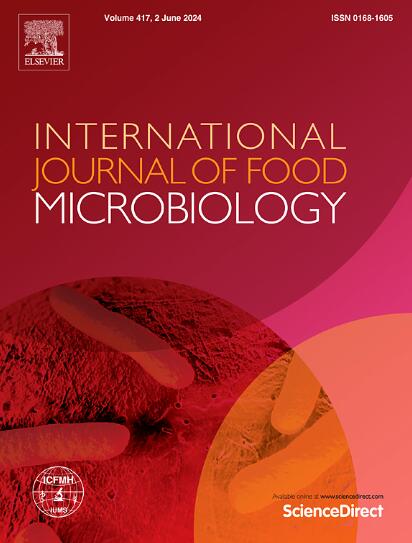Genetic diversity and the prevalence of Listeria monocytogenes in food in Shanghai, China: Insights during 2020–2023 surveillance and the Apriori algorithm approach
IF 5.2
1区 农林科学
Q1 FOOD SCIENCE & TECHNOLOGY
International journal of food microbiology
Pub Date : 2025-06-17
DOI:10.1016/j.ijfoodmicro.2025.111323
引用次数: 0
Abstract
Listeria monocytogenes poses a major global food safety concern as a widespread pathogen causing listeriosis. In this study, a total of 553 L. monocytogenes isolates across 9 food types sampled during 2020–2023 in Shanghai, the largest city in China, and among the largest metropolitan areas worldwide, were identified using whole-genome sequencing (WGS). The association among clonal complexes (CCs) and food matrices was determined using an Apriori algorithm approach. Results revealed that less virulent CC9 and CC121 isolates without LIPI-2-4 were the predominant strains frequently detected, showing strong association with pork, beef, lamb, chicken, and processed meat products, suggesting their widespread presence in various meat types. Virulent CC8 without LIPI-2-4 was predominantly found in processed meat products, cooked meat products, and clinical cases. More virulent CC87 with LIPI-4 was frequently detected in clinical cases and chicken. Similarly, CC2 with LIPI-3 showed a strong association with seafood products. Therefore, the observed CCs aligned with previously defined virulence classes, offering valuable data for microbiological risk assessment. Further research is necessary to explore unique CCs in China and the virulence profiles. Nevertheless, this study highlights the insufficiency of relying solely on LIPI-1-4 for determining L. monocytogenes pathogenicity. Notably, the presence of inlA PMSC mutations revealed the distribution of virulence potential of L. monocytogenes, which might be helpful to improve risk assessment approaches. Furthermore, incorporating CCs into L. monocytogenes surveillance may aid in tracing contamination sources and monitoring transmission patterns, offering insights for risk assessment.
遗传多样性和中国上海食品中单核增生李斯特菌的流行:2020-2023年监测和Apriori算法方法的见解
单核细胞增生李斯特菌是引起李斯特菌病的一种广泛存在的病原体,引起了全球主要的食品安全问题。本研究利用全基因组测序(WGS)技术,对2020-2023年在中国最大城市上海和全球最大大都市地区采集的9种食物中分离到的553株单核细胞增生乳杆菌进行了鉴定。克隆复合体(CCs)和食物基质之间的关联使用Apriori算法方法确定。结果显示,不含LIPI-2-4的CC9和CC121分离株毒力较弱,是常见的优势菌株,与猪肉、牛肉、羊肉、鸡肉和加工肉制品有很强的相关性,表明它们广泛存在于各种肉类中。不含LIPI-2-4的毒性CC8主要存在于加工肉制品、熟肉制品和临床病例中。含有LIPI-4的CC87在临床病例和鸡中毒性更强。同样,CC2和LIPI-3与海产品有很强的相关性。因此,观察到的cc与先前定义的毒力等级一致,为微生物风险评估提供了有价值的数据。有必要进一步研究中国独特的cc及其毒力特征。然而,本研究强调了仅依靠LIPI-1-4来确定单核增生乳杆菌致病性的不足。值得注意的是,inlA PMSC突变的存在揭示了单核增生乳杆菌的毒力潜力分布,这可能有助于改进风险评估方法。此外,将CCs纳入单核增生乳杆菌监测可能有助于追踪污染源和监测传播模式,为风险评估提供见解。
本文章由计算机程序翻译,如有差异,请以英文原文为准。
求助全文
约1分钟内获得全文
求助全文
来源期刊
CiteScore
10.40
自引率
5.60%
发文量
322
审稿时长
65 days
期刊介绍:
The International Journal of Food Microbiology publishes papers dealing with all aspects of food microbiology. Articles must present information that is novel, has high impact and interest, and is of high scientific quality. They should provide scientific or technological advancement in the specific field of interest of the journal and enhance its strong international reputation. Preliminary or confirmatory results as well as contributions not strictly related to food microbiology will not be considered for publication.

 求助内容:
求助内容: 应助结果提醒方式:
应助结果提醒方式:


